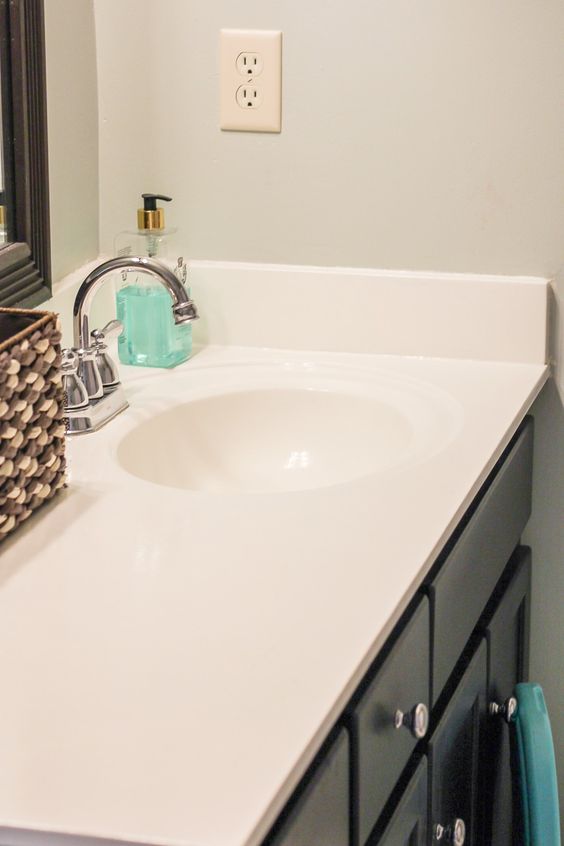In daily life, the bathroom sink is one of the areas we use frequently, but what is often overlooked is that it requires regular cleaning and maintenance. Whether it’s made of stainless steel, ceramic, or composite materials, your sink can lose its luster over time due to the buildup of residue and scale, which not only affects its appearance but can also harbor bacteria. Therefore, knowing how to properly clean your bathroom sink is one of the keys to keeping your entire bathroom clean and hygienic.

image from Sweeten
Tools you need:
Sponge or brush
Soft bristle toothbrush
Cleanser or white vinegar
Disinfectant wipes or disinfectant spray
microfiber cloth
Clean the countertop:
Remove all supplies placed on the sink countertop for easy cleaning.
Disinfection:
Before starting to clean, disinfect the sink area. Use disinfectant wipes or disinfectant spray to spray lightly and keep the area moist for about ten minutes before proceeding to the next step.
Pour hot water:
Pour hot water and let it soak in the sink for a while. This will help soften the dirt attached to the sink and make cleaning easier.
Use cleaner or white vinegar:
You can choose to clean your sink with a commercial chemical cleaner or the more eco-friendly white vinegar. Spray or pour the cleaner evenly down the sink and leave it for some time to penetrate and break down dirt.
Scrub with a brush or sponge:
Using a sponge or soft-bristled brush, carefully scrub the surface of the sink. For tight corners and hard-to-reach areas, you can use a soft-bristled toothbrush to scrub. Scrub several times until the dirt is completely removed.
Rinse:
Rinse the sink with clean water, making sure to remove all detergent residue and debris.
Drying and wiping:
Dry the sink surface with a clean microfiber cloth or paper towel to prevent water stains and limescale from forming.
Clean Different Types of Sinks
Stainless steel sink:
Use a mild detergent or a cleaner specifically designed for use on stainless steel. Avoid using strongly acidic cleaners containing ammonia or chlorine as they may damage stainless steel surfaces.
Gently scrub the surface with a soft cloth or sponge. Never use hard brushes or abrasives to avoid scratching the stainless steel.
Rinse well and dry with a dry cloth to prevent limescale from settling.
Ceramic/Porcelain sinks:
Clean your ceramic sink with a mild detergent or a paste made by mixing baking soda and water. Baking soda helps remove dirt without damaging the porcelain surface.
Use a soft cloth or sponge to scrub gently and avoid using abrasives or hard brushes that can scratch the surface of the sink.
Rinse well and dry to avoid water stains and limescale formation.
Composite sinks (such as granite composite sinks):
Avoid using cleaners containing acidic or abrasive particles as they may damage the composite surface.
Use a mild detergent or a cleaning product specifically designed for use on laminate and scrub the sink surface as directed.
Wipe the sink dry with a soft cloth to prevent water stains and marks.
Whatever cleaning method you use, be careful to be gentle and avoid using chemical cleaners or abrasives that are too strong to avoid damaging the surface of your sink. Also be sure to read the cleaning agent’s instructions and follow the manufacturer’s recommendations when cleaning to avoid damage.
Tips for Keeping Your Bathroom Sink Sparkling
Regular Cleaning: Regular cleaning is key to keeping your sink sparkling. Try to perform a thorough cleaning once a week to prevent the build-up of dirt and scale.
Dry the sink: Use a soft cloth or paper towel to dry the sink surface. This prevents water stains and limescale from forming.
Precautions: Try to avoid placing bleach or products containing strong acids in the sink, as these may damage the surface of the sink. In addition, used wet cloths or sponges may contain bacteria. Wash and dry them promptly to prevent bacterial growth.
Keep drains clear to prevent water from accumulating in sinks.

image from Designing Vibes
Keeping your bathroom sink clean is not difficult, but it is crucial to maintaining overall hygiene. Proper cleaning methods, regular maintenance, and using the right cleaning agents can keep your sink sparkling, extend its life, and create a clean, hygienic bathroom space. No matter what material the sink is made of, we can maintain its beauty and hygiene with the right methods and consistent careful cleaning, so that our bathrooms always look attractive.
READ MORE:How to Clean a Bathroom Floor